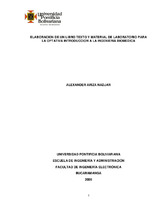Mostrar el registro sencillo del ítem
Elaboración de un libro texto y material de laboratorio para la optativa introducción a la ingenieria Biomédica
| dc.contributor.advisor | Cristancho, Sayra, Magnolia | |
| dc.contributor.author | Ariza Nadjar, Alexander | |
| dc.coverage.spatial | Seccional Bucaramanga. Universidad Pontificia Bolivariana. Escuela de Ingenierías. Facultad de Ingeniería Electrónica | spa |
| dc.coverage.temporal | 2009 | |
| dc.date.accessioned | 2013-07-16T21:53:45Z | |
| dc.date.available | 2013-07-16T21:53:45Z | |
| dc.date.created | 2009-07-22 | |
| dc.date.issued | 2013-07-16 | |
| dc.identifier.uri | http://hdl.handle.net/20.500.11912/495 | |
| dc.description | 113p.: (pdf); il; tablas; gráficas | spa |
| dc.description.abstract | El presente trabajo tiene como objetivo principal solucionar dos problemas que presenta el desarrollo adecuado de la materia optativa Introducción a la Ingeniería Biomédica. El primero es que la bibliografía actual a la que pueden recurrir los estudiantes es limitada, en comparación con las otras áreas de la electrónica estudiadas dentro de la universidad. Además de la limitada, la mayoría se encuentran en idioma ingles por lo cual el proceso de aprendizaje encuentra dificultades. Además se encuentra que el proceso de aprendizaje es mucho más rápido y fácil para los estudiantes si la materia en curso posee un libro texto. La estructura del presente proyecto está constituido por diez (10) capítulos, determinados por las áreas más importantes de la Ingeniería Biomédica, como son: Sistemas fisiológicos, Electrofisiología, Bioinstrumentación, Biomecánica y Biomateriales, Imagenología Medica, Simulación Quirúrgica, Robótica Medica, Telemedicina, Equipos hospitalarios y por ultimo Ingeniería Clínica y Tendencias en investigación. Cada capítulo posee además una evaluación, compuesta por preguntas variadas basadas en la información ofrecida en los subcapítulos, para que de esta forma tanto el estudiante como el profesor puedan dar una valoración del aprendizaje. También se hace entrega de los prototipos y las guías de desarrollo de tres (3) proyectos de laboratorio. Los proyectos son: Diseño y construcción de un ECG de 3 derivaciones, Diseño de un Monitor de Frecuencia Cardiaca, y el Diseño y construcción de un EMG. Al final de cada proyecto también se evalúa, para su informe, si el estudiante ha logrado aprender algo con los objetivos. Por último, adicional a las guías se hace entrega de dos (2) PCBs con el ECG y EMG funcionando correctamente y un programa basado en el software de programación LABVIEW con el Monitor de Frecuencia Cardiaca implementado. | spa |
| dc.description.abstract | The present work has as main objective to solve two problems that are present in the adequate development of the optative class Introduction to Biomedical Engineering. First, the current bibliography to which students can resort is limited, in comparison with the other areas of electronics studied in the university. Besides, most of those are found to be in English language, meaning that the learning process finds a lot of difficulties. On the other hand, it’s the fact that the learning process is a lot faster and easier to students if the coursing class posses a text book. The structure of the present project has as end to be attractive to student, is composed by ten (10) chapters, determined by the most important areas of Biomedical Engineering, as are: Physiologic Systems, Electrophysiology, Bioinstrumentation, Biomechanics and Biomaterials, Medical Imaging, Surgery Simulation, Medical Robotics, Telemedicine, Hospital Equipment, and finally Clinical Engineering and Investigation tendencies. Finally, every chapter has an evaluation, composed by varied questions based in the information offered in the subchapters, so both the student and teacher can give a valuation of the learning process. Having under consideration that a class is more didactic if the previously knowledge studied in a classroom are applied to the development of distinct projects, is also given the prototypes and development guides of three (3) lab projects. The projects are: Design and construction of a 3 leads ECG, Design of a cardiac frequency monitor, and the Design and construction of an EMG. With this lab projects the student will be able to apply part of the acquired knowledge in the development of the class. Every guide posses an organized structure to its development, with is due previously preparation, as also different questions that the student must respond as the project advances. At the end of each Project is also evaluated, to its report, if the student has managed to learn something from the objectives. Finally, additional to the guides are also given two (2) PCBs with the ECG and EMG working properly, and a program based in the software LABVIEW with the implemented cardiac frequency monitor. | |
| dc.language.iso | es | |
| dc.rights | Attribution-NonCommercial-NoDerivatives 4.0 International | * |
| dc.rights.uri | http://creativecommons.org/licenses/by-nc-nd/4.0/ | * |
| dc.subject | Ingeniería electrónica | spa |
| dc.subject | Tesis y disertaciones académicas | spa |
| dc.subject | Ingeniería biomédica | spa |
| dc.subject | Bioinstrumentación | spa |
| dc.subject | Robótica médica | spa |
| dc.subject | Electrofisiología | spa |
| dc.title | Elaboración de un libro texto y material de laboratorio para la optativa introducción a la ingenieria Biomédica | spa |
| dc.type | bacherlorThesis | spa |
| dc.rights.accessRights | openAccess | spa |
| dc.type.hasVersion | publishedVersion | spa |
| dc.identifier.instname | instname:Universidad Pontificia Bolivariana | spa |
| dc.identifier.reponame | reponame:Repositorio Institucional de la Universidad Pontificia Bolivariana | spa |
| dc.identifier.repourl | repourl:https://repository.unab.edu.co/ |
Ficheros en el ítem
Este ítem aparece en la(s) siguiente(s) colección(ones)
-
Trabajos de grado [6698]
Monografías, artículos, informes, proyecto de grado


